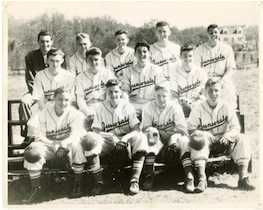The Day School Continued
Transforming the Juniorate into a Day School

One of the new Ordinary’s first concerns was education. On August 7, 1957, Rev. Edgar P. McCarren, Superintendent of Schools of the new diocese, telephoned Brother Bernadine, the Franciscan Brothers’ Supervisor of Schools, requesting that the Juniorate be transformed into a day school to serve the surrounding area. The suggestion posed problems: Cafeteria space would be almost as vital as expanding the faculty, for the school would be at least doubled in size. The library was already adequate, but a qualified librarian would have to be hired. The athletic program would have to be expanded, and a social program instituted. If the dormitory and the Brothers’ bedrooms were converted into classrooms, new quarters would have to be found for them.
One of the new Ordinary’s first concerns was education. On August 7, 1957, Rev. Edgar P. McCarren, Superintendent of Schools of the new diocese, telephoned Brother Bernadine, the Franciscan Brothers’ Supervisor of Schools, requesting that the Juniorate be transformed into a day school to serve the surrounding area. The suggestion posed problems: Cafeteria space would be almost as vital as expanding the faculty, for the school would be at least doubled in size. The library was already adequate, but a qualified librarian would have to be hired. The athletic program would have to be expanded, and a social program instituted. If the dormitory and the Brothers’ bedrooms were converted into classrooms, new quarters would have to be found for them.
Since the Novitiate had moved to a new location in 1949, the Mills house had become St. Bonaventure Postulate. It now became the residence for the Juniorate boys and the faculty, but only after extensive repairs and renovations. It was felt, however, that a larger school would enable the Brothers to expand the academic program, which would benefit the Juniorate boys as well as the new students.
On Monday after Labor Day in 1958, therefore, the Brothers and some 40 Juniorate boys were faced by the unfamiliar sight of a parade of cars (there were no school buses the first year) disgorging some 85 new students.
The atmosphere of the tiny school was more casual than it can be now. There were no lockers, Day boys left their books on a deacon’s bench in their cafeteria, and no one touched them. The Juniorate boys, who had a separate cafeteria, had cupboards there. Aside from the separate cafeteria and their blue and white sweaters or blazers, no distinctions were made between the two groups. All wore suit jackets and ties, though the sweaters allowed for boys who had earned a varsity letter could be substituted for the jackets. Juniorate boys wore a blue blazer with the school emblem, black trousers and a black tie. They had, of course, the advantage of living under the same roof with their teachers, and could easily obtain extra help with their studies, perhaps during the mandatory study hour at night. Also, they continued to have chores about the house and grounds.
One practice which has been discontinued was the assignment of boys to homerooms according to IQ. Today, of course, the alphabet rules in homeroom, and a student can be assigned to Honors classes in individual subjects without being segregated from his classmates.
Assemblies were held in front of the brick building, the speaker standing on the porch, the boys gathered in front of it. Graduation ceremonies were another innovation required by the institution of the day school. They were held in the grotto.
In 1958, no freshmen were admitted, but from 1959 onward, normal procedures were followed, allowing a gradual growth to the present population of just under 1,000.
In a small school in which everyone knows everyone else, at least to know his name, rapport is likely to be excellent and spirit high. The bonds between student and student and between faculty and students grew very strong. The school came to be referred to as “the country club.” Why not, when it even had a flying club and the yearbook boasted aerial photos taken by students?
On December 5, 1959, Bishop Kellenberg presided over a Pontifical Mass celebrating the school’s twenty-fifth anniversary at St. Josephs Church in King’s Park. The homilist, Very Rev. Eugene Crawford, stressed the role of the Juniorate in providing capable teachers and devoted leadership for the Franciscan order, and the values of St. Francis for those who wish to live according to the Gospel.
On December 5, 1959, Bishop Kellenberg presided over a Pontifical Mass celebrating the school’s twenty-fifth anniversary at St. Josephs Church in King’s Park. The homilist, Very Rev. Eugene Crawford, stressed the role of the Juniorate in providing capable teachers and devoted leadership for the Franciscan order, and the values of St. Francis for those who wish to live according to the Gospel.
